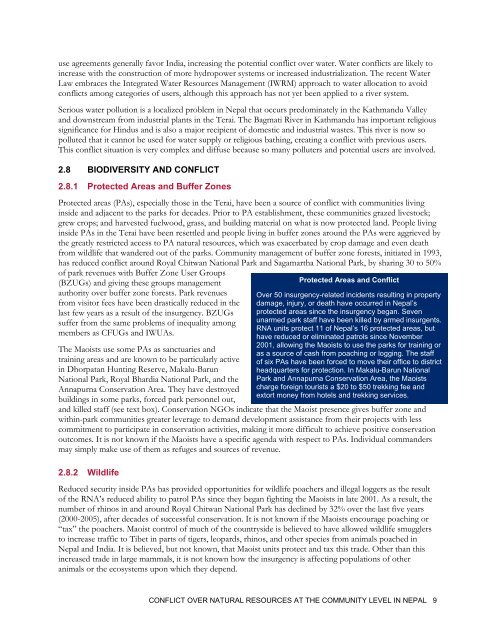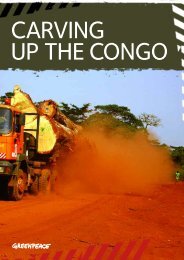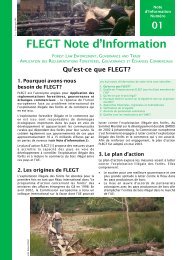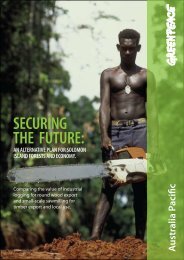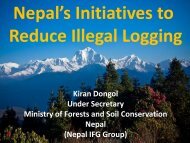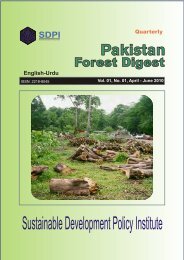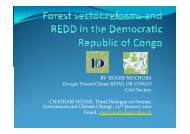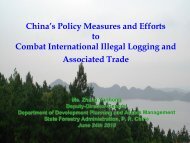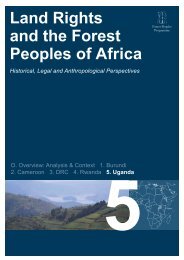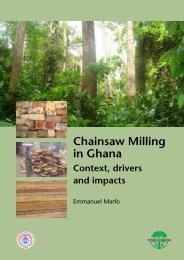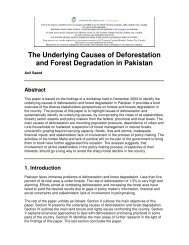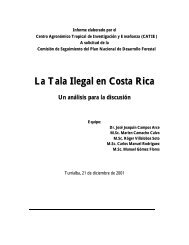conflict over natural resources at the community level in nepal
conflict over natural resources at the community level in nepal
conflict over natural resources at the community level in nepal
Create successful ePaper yourself
Turn your PDF publications into a flip-book with our unique Google optimized e-Paper software.
use agreements generally favor India, <strong>in</strong>creas<strong>in</strong>g <strong>the</strong> potential <strong>conflict</strong> <strong>over</strong> w<strong>at</strong>er. W<strong>at</strong>er <strong>conflict</strong>s are likely to<strong>in</strong>crease with <strong>the</strong> construction of more hydropower systems or <strong>in</strong>creased <strong>in</strong>dustrializ<strong>at</strong>ion. The recent W<strong>at</strong>erLaw embraces <strong>the</strong> Integr<strong>at</strong>ed W<strong>at</strong>er Resources Management (IWRM) approach to w<strong>at</strong>er alloc<strong>at</strong>ion to avoid<strong>conflict</strong>s among c<strong>at</strong>egories of users, although this approach has not yet been applied to a river system.Serious w<strong>at</strong>er pollution is a localized problem <strong>in</strong> Nepal th<strong>at</strong> occurs predom<strong>in</strong><strong>at</strong>ely <strong>in</strong> <strong>the</strong> K<strong>at</strong>hmandu Valleyand downstream from <strong>in</strong>dustrial plants <strong>in</strong> <strong>the</strong> Terai. The Bagm<strong>at</strong>i River <strong>in</strong> K<strong>at</strong>hmandu has important religioussignificance for H<strong>in</strong>dus and is also a major recipient of domestic and <strong>in</strong>dustrial wastes. This river is now sopolluted th<strong>at</strong> it cannot be used for w<strong>at</strong>er supply or religious b<strong>at</strong>h<strong>in</strong>g, cre<strong>at</strong><strong>in</strong>g a <strong>conflict</strong> with previous users.This <strong>conflict</strong> situ<strong>at</strong>ion is very complex and diffuse because so many polluters and potential users are <strong>in</strong>volved.2.8 BIODIVERSITY AND CONFLICT2.8.1 Protected Areas and Buffer ZonesProtected areas (PAs), especially those <strong>in</strong> <strong>the</strong> Terai, have been a source of <strong>conflict</strong> with communities liv<strong>in</strong>g<strong>in</strong>side and adjacent to <strong>the</strong> parks for decades. Prior to PA establishment, <strong>the</strong>se communities grazed livestock;grew crops; and harvested fuelwood, grass, and build<strong>in</strong>g m<strong>at</strong>erial on wh<strong>at</strong> is now protected land. People liv<strong>in</strong>g<strong>in</strong>side PAs <strong>in</strong> <strong>the</strong> Terai have been resettled and people liv<strong>in</strong>g <strong>in</strong> buffer zones around <strong>the</strong> PAs were aggrieved by<strong>the</strong> gre<strong>at</strong>ly restricted access to PA <strong>n<strong>at</strong>ural</strong> <strong>resources</strong>, which was exacerb<strong>at</strong>ed by crop damage and even de<strong>at</strong>hfrom wildlife th<strong>at</strong> wandered out of <strong>the</strong> parks. Community management of buffer zone forests, <strong>in</strong>iti<strong>at</strong>ed <strong>in</strong> 1993,has reduced <strong>conflict</strong> around Royal Chitwan N<strong>at</strong>ional Park and Sagamartha N<strong>at</strong>ional Park, by shar<strong>in</strong>g 30 to 50%of park revenues with Buffer Zone User Groups(BZUGs) and giv<strong>in</strong>g <strong>the</strong>se groups managementauthority <strong>over</strong> buffer zone forests. Park revenuesfrom visitor fees have been drastically reduced <strong>in</strong> <strong>the</strong>last few years as a result of <strong>the</strong> <strong>in</strong>surgency. BZUGssuffer from <strong>the</strong> same problems of <strong>in</strong>equality amongmembers as CFUGs and IWUAs.The Maoists use some PAs as sanctuaries andtra<strong>in</strong><strong>in</strong>g areas and are known to be particularly active<strong>in</strong> Dhorp<strong>at</strong>an Hunt<strong>in</strong>g Reserve, Makalu-BarunN<strong>at</strong>ional Park, Royal Bhardia N<strong>at</strong>ional Park, and <strong>the</strong>Annapurna Conserv<strong>at</strong>ion Area. They have destroyedbuild<strong>in</strong>gs <strong>in</strong> some parks, forced park personnel out,and killed staff (see text box). Conserv<strong>at</strong>ion NGOs <strong>in</strong>dic<strong>at</strong>e th<strong>at</strong> <strong>the</strong> Maoist presence gives buffer zone andwith<strong>in</strong>-park communities gre<strong>at</strong>er leverage to demand development assistance from <strong>the</strong>ir projects with lesscommitment to particip<strong>at</strong>e <strong>in</strong> conserv<strong>at</strong>ion activities, mak<strong>in</strong>g it more difficult to achieve positive conserv<strong>at</strong>ionoutcomes. It is not known if <strong>the</strong> Maoists have a specific agenda with respect to PAs. Individual commandersmay simply make use of <strong>the</strong>m as refuges and sources of revenue.2.8.2 WildlifeProtected Areas and ConflictOver 50 <strong>in</strong>surgency-rel<strong>at</strong>ed <strong>in</strong>cidents result<strong>in</strong>g <strong>in</strong> propertydamage, <strong>in</strong>jury, or de<strong>at</strong>h have occurred <strong>in</strong> Nepal’sprotected areas s<strong>in</strong>ce <strong>the</strong> <strong>in</strong>surgency began. Sevenunarmed park staff have been killed by armed <strong>in</strong>surgents.RNA units protect 11 of Nepal’s 16 protected areas, buthave reduced or elim<strong>in</strong><strong>at</strong>ed p<strong>at</strong>rols s<strong>in</strong>ce November2001, allow<strong>in</strong>g <strong>the</strong> Maoists to use <strong>the</strong> parks for tra<strong>in</strong><strong>in</strong>g oras a source of cash from poach<strong>in</strong>g or logg<strong>in</strong>g. The staffof six PAs have been forced to move <strong>the</strong>ir office to distric<strong>the</strong>adquarters for protection. In Makalu-Barun N<strong>at</strong>ionalPark and Annapurna Conserv<strong>at</strong>ion Area, <strong>the</strong> Maoistscharge foreign tourists a $20 to $50 trekk<strong>in</strong>g fee andextort money from hotels and trekk<strong>in</strong>g services.Reduced security <strong>in</strong>side PAs has provided opportunities for wildlife poachers and illegal loggers as <strong>the</strong> resultof <strong>the</strong> RNA’s reduced ability to p<strong>at</strong>rol PAs s<strong>in</strong>ce <strong>the</strong>y began fight<strong>in</strong>g <strong>the</strong> Maoists <strong>in</strong> l<strong>at</strong>e 2001. As a result, <strong>the</strong>number of rh<strong>in</strong>os <strong>in</strong> and around Royal Chitwan N<strong>at</strong>ional Park has decl<strong>in</strong>ed by 32% <strong>over</strong> <strong>the</strong> last five years(2000-2005), after decades of successful conserv<strong>at</strong>ion. It is not known if <strong>the</strong> Maoists encourage poach<strong>in</strong>g or“tax” <strong>the</strong> poachers. Maoist control of much of <strong>the</strong> countryside is believed to have allowed wildlife smugglersto <strong>in</strong>crease traffic to Tibet <strong>in</strong> parts of tigers, leopards, rh<strong>in</strong>os, and o<strong>the</strong>r species from animals poached <strong>in</strong>Nepal and India. It is believed, but not known, th<strong>at</strong> Maoist units protect and tax this trade. O<strong>the</strong>r than this<strong>in</strong>creased trade <strong>in</strong> large mammals, it is not known how <strong>the</strong> <strong>in</strong>surgency is affect<strong>in</strong>g popul<strong>at</strong>ions of o<strong>the</strong>ranimals or <strong>the</strong> ecosystems upon which <strong>the</strong>y depend.CONFLICT OVER NATURAL RESOURCES AT THE COMMUNITY LEVEL IN NEPAL 9


